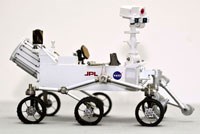
Siemens, too, had made every effort to give NASA the best possible support in advance of the mission - with its product lifecycle management (PLM) software. A highly specialised team consisting of scientists and engineers at the NASA Jet Propulsion Laboratory (JPL) used PLM software in the design, planning, and construction of the Mars rover, so that "Curiosity" would be able to withstand the intense conditions from takeoff to landing.
Right at the start of the design phase, the NASA developers laid out the six-wheeled laboratory using Siemens' PLM software. Specifically, they made use of the NX interactive design, manufacturing, and engineering system, as well as the Teamcentre collaborative data management system. This made it possible to virtually assemble "Curiosity" and precisely simulate the functions. Since no physical prototype had to be built beforehand, one major advantage was that material costs were kept low. Ultimately this led to what is today the most technologically advanced rover ever. "It will further enhance our understanding of the Red Planet, while paving the way for future human exploration," said Doug McCuistion, NASA Director of the Mars Exploration Program. And some of the thanks goes to Siemens PLM software.
Primarily developed in the aerospace and automotive industries, PLM software is now seeing increased use in other industries. It is designed to ensure that companies can become more productive and responsive despite ever-shorter development times, and thereby increase their competitiveness. "With our unique Siemens combination of PLM software and automation technology, we not only cut time to market by up to 50% but also save resources and energy costs," says Siegfried Russwurm, member of the Siemens Board and CEO of the Industry Sector.
Another outcome will be to make space travel more feasible, since space exploration can only move ahead if it is cost-effective. With the Mars landing, Siemens PLM has successfully completed its part of the mission - and now "Curiosity" can begin its work.

This is one of the first images taken by NASA's Curiosity rover, which landed on Mars on the morning of 6 August 2012. It was taken through a fisheye wide-angle lens on the left "eye" of a stereo pair of Hazard-Avoidance cameras on the left-rear side of the rover. The image is one-half of full resolution. The clear dust cover that protected the camera during landing has been sprung open. Part of the spring that released the dust cover can be seen at the bottom right, near the rover's wheel.
On the top left, part of the rover's power supply is visible.
Some dust appears on the lens even with the dust cover off.
The cameras are looking directly into the sun, so the top of the image is saturated. Looking straight into the sun does not harm the cameras. The lines across the top are an artefact called "blooming" that occurs in the camera's detector because of the saturation.
As planned, the rover's early engineering images are lower resolution. Larger colour images from other cameras are expected later in the week when the rover's mast, carrying high-resolution cameras, is deployed.
(Image: NASA/JPL-Caltech)